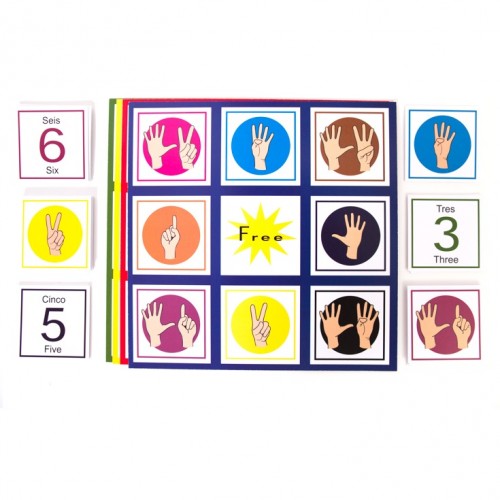Product Description
What is included?
This is a game for up to four players. It includes four two-sided bingo boards, each board in a different color. One side of the board is a finger pattern and color for beginning players. The alternate side is the corresponding number, number word and color to be used by advanced players. Thirty three two-sided bingo squares are used to get a BINGO!
Why did we create it?
Is your student or child beginning to show you their age on their fingers or how many cookies they would like? That is what inspired us to make ArithmaKids bingo. We made an early-childhood finger pattern game that encourages finger patterns, number recognition that incorporates color. The finger pattern side is perfect for your new counter, while the opposite side is great for next step of reading and writing numbers.
What does it teach?
ArithmaKids Bingo can be used in small group, one-on-one and as a carryover game for at home. Students are working on colors, finger patterns and the written and symbolic representation of each finger pattern.
Applicable Kindergarten Common Core State Standards:
-
CCSS.Math.Content.K.CC.B.4 Understand the relationship between numbers and quantities; connect counting to cardinality.
-
CCSS.Math.Content.K.CC.C.6 Identify whether the number of objects in one group is greater than, less than, or equal to the number of objects in another group, e.g., by using matching and counting strategies.
-
CCSS.Math.Content.K.CC.C.7 Compare two numbers between 1 and 10 presented as written numerals.
-
CCSS.Math.Content.K.OA.A.1 Represent addition and subtraction with objects, fingers, mental images, drawings1, sounds (e.g., claps), acting out situations, verbal explanations, expressions, or equations.
-
CCSS.Math.Content.K.OA.A.3 Decompose numbers less than or equal to 10 into pairs in more than one way, e.g., by using objects or drawings, and record each decomposition by a drawing or equation (e.g., 5 = 2 + 3 and 5 = 4 + 1).
-
CCSS.Math.Content.K.OA.A.4 For any number from 1 to 9, find the number that makes 10 when added to the given number, e.g., by using objects or drawings, and record the answer with a drawing or equation.
- CCSS.Math.Content.K.OA.A.5 Fluently add and subtract within 5

